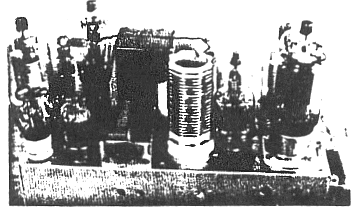
Egad! A Nine Tube Linear, Bob Baird, 73 Magazine, Jan 1982
This article, despite its title, investigates the characteristics of 9 different types of tubes we normally might use for an amplifier. It includes experimental data with tables, and is quite informative.
(Click on the image to download the .PDF of the article)
"The 'Junker' Amplifier", by Lew McCoy W1ICP, from QST, Oct 1970. This amp is built from scrounged and junk-box parts, can be built using any of several different tubes, and has an input of 500 watts, 80 through 10 meters. This is another of our "idea" sources.
(Click on the picture of the amp to download the PDF file of the article.)
The following .PDF files are from articles in various ARRL Publications, put here with permission of the League.
Here are some bits of information on cathode-modulation and a simple cathode modulator for your convenience.
The first is an article written by our own Dennis Brady W5FRS and Patrick Jankowiak, and is quite detailed, discussing their success with a cathode modulator for Dennis' 250TH CW amp. And here is Dennis' main page
Here is a .PDF file, is from the 1956 ARRL Handbook, page 250, entitled "A Simple Grid Modulator". This extremely simple modulator plugs into the key jack of any cathode keyed rig . The title may be somewhat misleading to the uninitiated, but cathode modulation actually combines grid and plate modulation, and the efficiency of the final amp is midway between the efficiency of grid and plate modulation methods. This circuit, with some very slight differences, was possibly first published in the Radio Handbook by Editors and Engineers prior to 1940, and has been re-published in various articles and handbooks ever since. Included here is a nearly identical article from the September, 1953 issue of "QST" magazine , entitled "The Simplest Modulator" .
1) Here is a .PDF file of an article in an early, circa 1925 QST magazine concerning how to make your own crystals, from cutting the quartz slab from a block of quartz with a hacksaw with the blade in backwards, to making your own mounts. There is a TERRIBLE lot of work involved to make even one crystal.
2) Here is a .PDF file of an article which was published in QST magazine in March of 1950 on Crystal Oscillators. This article contains a lot of test data and graphs, and shows quite clearly that of the tubes tested, the 6AG7 is by far the best choice.
1) Here is some data that Kees Talen took while attempting to find a proper tube to use in the low-voltage transmitter he is trying to design and build. LV Tube Comparison Data by Kees Talen 6 January 2005